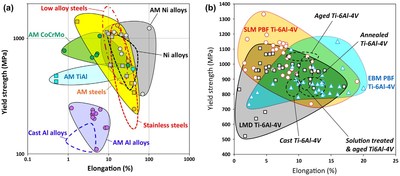
A 2017 review by Stéphane Gorsse and colleagues published in Science and Technology of Advanced Materials offers a comprehensive overview of structure–property relationships for three important types of alloys: steels, Ti-6Al-4V and high-entropy alloys. These three materials represent different so-called technology readiness levels, meaning that their usages have reached different levels of technological maturity. The review article has now been awarded the 2019 STAM Journal's Best Paper Award.
Video of Stéphane Gorsse describing his research activities and the background to writing this award winning paper.
Stéphane Gorsse, Christopher Hutchinson, Mohamed Gouné and Rajarshi Banerjee, Science and Technology of Advanced Materials 18, 584-610 (2017)
https://doi.org/10.1080/14686996.2017.1361305
Gorsse, a metallurgist studying the relationships between processing, microstructure and properties using computational thermodynamics, said: "I wanted to write a review on AM, because this is one of the key ingredients of the 4th industrial revolution." Together with co-authors Christopher Hutchinson, Mohame Gouné and Rajarshi Banerjee, he decided to focus on the microstructural development in 3D-printed metal products. "One of the main challenges with AM is to gain better control of the mechanical properties", explains Gorsse. "This is a very complicated problem, because the macrostructure depends on many interactions between the [metal] powder, the laser and the electron beam [used to 'print' materials layer by layer], and there are so many parameters to be optimized."
The authors discuss how AM-induced metallurgical defects in Ti-6Al-4V alloys (known for their excellent corrosion resistance and low density) affect their mechanical properties such as ductility and tensile strength. For steels, Gorsse and colleagues discussed AM-induced effects such as increased surface roughness, larger dislocation density and different phase stability. Finally, the scientists looked at high-entropy alloys — compounds that contain relatively large fractions of 5 or more metals — and concluded that due to the large temperature gradients involved, rapid solidification takes place, which helps the formation of high-quality alloys.
On receiving the 2019 STAM Journal's Best Paper Award, Gorsse said: "I am feeling very lucky and honoured to receive this award from a leading open-access journal having a big audience." Regarding future directions of research on alloys produced by AM, the scientist thinks that two fields need to be brought together: computational thermodynamics, to better understand what processes take place, and artificial intelligence/machine learning, to get better printed products.
Reference
Stéphane Gorsse, Christopher Hutchinson, Mohamed Gouné and Rajarshi Banerjee, Science and Technology of Advanced Materials 18, 584-610 (2017)
https://doi.org/10.1080/14686996.2017.1361305
About NIMS and STAM
NIMS and Empa have jointed efforts to develop a flagship journal that provides highly-quality information on recent developments in materials science within an open access platform. The collaboration will strengthen the position of STAM in Europe.
Further information about press release:
Science and Technology of Advanced Materials (STAM) Headquarter Office, National Institute for Materials Science (NIMS)
Address: 1-2-1 Sengen, Tsukuba 305-0047
EMAIL:
stam-info@ml.nims.go.jp
Photo: https://mma.prnewswire.com/media/1056164/AM_Stam_Awards.jpg
| Contact: |
| Company Name: Science and Technology of Advanced Materials
|
